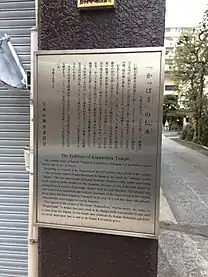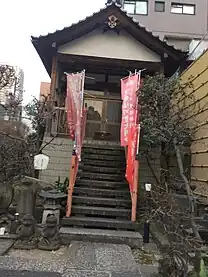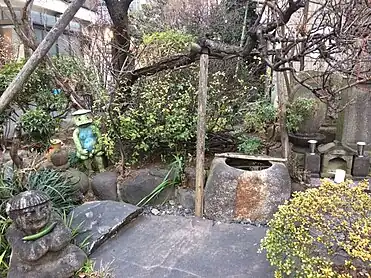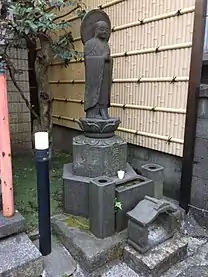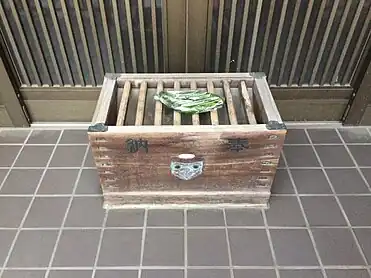Kappa-dera
Kappa-dera (かっぱ寺), also known as Sōgen Temple (曹源寺, "Sōgen-ji") is a Zen Buddhist temple in the Kappabashi area of Tokyo and is named after the kappa, a Japanese folklore figure.
| Kappa-dera | |
|---|---|
曹源寺 | |
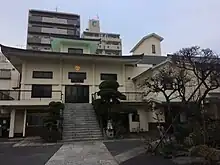 Kappa-dera | |
| Religion | |
| Affiliation | Buddhism |
| Sect | Sōtō |
| Deity | Shakyamuni Buddha |
| Location | |
| Location | 3-7-2 Matsugaya, Taitō, Tokyo |
| Country | Japan |
| Geographic coordinates | 35°42′55″N 139°47′11″E |
History
The temple was founded as a Sōtō Zen temple first built in the Marunouchi area of Tokyo in 1588. It changed location several times, moving to Yushima Tenman-gū because of the Edo Castle expansion in 1591. Finally in 1657 the Great fire of Meireki burned down most of the temple and it was moved to the current area in Matsugaya.[1] Historically, this area near Asakusa was prone to frequent flooding due to its proximity to the Sumida River, which would overflow its banks from Edo Bay.[2][3] In the 1800s, a local umbrella and raincoat merchant named Kihachi Kappaya started an effort to create a system to reduce the amount of destructive flooding in the area.[3][4] He invested his own capital to create embankments and a pedestrian bridge.[5]
There are several folktales about the building of this flood reduction setup that included controlled canal water drainage and bridge systems.[3] Many tales describe Kihachi receiving assistance to complete this project from a kappa, the Japanese folklore figure.[6] Other tales speak of impoverished samurai who would sell kappa raincoats near the bridge and that soldiers would hang their raincoats to dry near the bridge.[3] It is on the site of the bridge in these tales that the current temple is said to be built.[7] When Kihachi Kappaya died in 1814 he was buried at the temple, at this point also known as Kappaya Kawataro, another name for kappas and a joke meaning "kappa-selling kappa".[1][3]
Modern
In modern times, the temple is mostly known by its nickname, Kappa-dera, in relation to its location in Kappabashi, where the name trace its origins to both the name of a raincoat merchant (ja:合羽) and the kappa folklore.[3] The temple contains what is described as a mummified hand of a kappa.[8] The ceiling of the hall is decorated with illustrations by artists such as Osamu Tezuka.[3]
Kappa statues and depictions in a variety of forms surround the neighborhood and shopping district near the temple.[2] This area is known as Kappabashi and celebrates the kappa which they have made their mascot.[4] The temple grounds are open daily to tourists, although the building is not open to the public.[8] Cucumber offerings are often made to the kappas at the shrine, both to appease them and for businesses related to water.[6][5]
Gallery
|
References
- "-曹源寺- 歴史" [Sōgen-ji History]. sogenji.jp (in Japanese). 宗教法人 曹源寺. 2009. Retrieved November 16, 2017.
- Simone, Gianni (October 25, 2011). "Death, mystery and well-endowed tanuki: a tour of terrifying Tokyo". The Japan Times. Retrieved November 8, 2017.
- "What does Kappabashi mean?". Japan This!. February 26, 2014. Archived from the original on November 7, 2016. Retrieved November 14, 2017.
- Frauenfelder, Mark (September 22, 2010). "Idle Idol: The Japanese Mascot – a Boing Boing exclusive preview". Boing Boing. Retrieved November 14, 2017.
- "Sogen-ji Temple (Kappa-dera)". Hello Japan. Retrieved November 8, 2017.
- Lombardi, Linda (June 16, 2015). "Kappa: Japan's Aquatic, Cucumber-Loving, Booty-Obsessed Yokai". Tofugu. Retrieved November 8, 2017.
- Yoda, Hiroko; Alt, Matt (July 30, 2013). Yokai Attack!: The Japanese Monster Survival Guide (Revised ed.). Tuttle Publishing. pp. 32–33. ISBN 978-1-4629-0883-7. Retrieved November 8, 2017.
- Alt, Matt; Yoda, Hiroko; Joe, Melinda (2012). Frommer's Japan Day by Day (First ed.). Hoboken, New Jersey: John Wiley & Sons. p. 43. ISBN 978-0-470-90826-6. Retrieved November 8, 2017.
External links
- Official website
 (in Japanese)
(in Japanese)
